| Mercedes-Benz Citaro Hybrid | |
 |
|
| Manufacturer | EvoBus GmbH |
| Years in operation | 2020 – 2021 (Trial) |
| Operator | SBS Transit |
| Length | 12.1 metre |
| Engine | Mercedes-Benz OM 936 h |
| Transmission | Voith DIWA 854.6 |
| Accessibility | Low Floor & Wheelchair-accessible |
| Emission Standard | Euro VI (SCR+EGR) |
The Mercedes-Benz Citaro Hybrid (also stylised as Citaro hybrid, with lowercase ‘h’) is a low-floor, twin-axle, diesel-hybrid city bus built by Mercedes-Benz and EvoBus GmbH. First unveiled in 2017, the mild hybrid bus pairs the existing diesel engine with a supercapacitor for reduced fuel consumption.
One such Citaro hybrid bus was brought into Singapore in 2019 and offered to the Land Transport Authority for revenue service trials. Registered to SBS Transit as SG4004B under a Special Purpose License, the bus was authorised for deployment on bus Services 93 and 272 for one year (9 March 2020–8 March 2021, both dates inclusive).
On 13 March 2020, the bus made its revenue service debut on Bus Service 272. The bus later continued the second phase of its trial on Bus Service 93, starting on 21 September 2020, with its last day of service on 8 March 2021.
The diesel version of the Mercedes-Benz Citaro in Singapore is covered in this article.
Singapore Background:
The Citaro hybrid belongs to Mercedes Benz’ popular Citaro range of city buses, with over 55,555 Citaro buses built from 1997 to 2019. Excluding the Citaro hybrid, all Citaro buses in Singapore are of the Euro V Diesel version. These buses are manufactured in Mannheim (Germany) and shipped completely built-up (CBU) to Singapore. Citaros are also offered with CNG engines, and as diesel-hybrid, CNG-hybrid or full-electric vehicles.
First introduced locally in 2010 by SMRT Buses, and with follow-up orders by SBS Transit, the Citaro is among the most common bus models in Singapore (at around 1000 buses) with deliveries from 2011–2016, later further increased by the Land Transport Authority (LTA). Starting in 2016, these buses were also leased to other operators under the Bus Contracting Model.
Citaro hybrid – Technical Information:
The Citaro hybrid was first unveiled at Busworld Europe 2017. As a mild hybrid vehicle, it was designed to hone the internal combustion engine for maximum efficiency with minimal modifications. The hybrid technology is offered as a piece of optional equipment for its existing Citybus range (both diesel and gas engines). Being lightweight and technically straightforward, the space-efficient design required little modifications to the interior and exterior of the bus.
As the hybrid system assists the combustion engine only during periods of high power demand, output and torque figures for the bus remain unchanged. Supercapacitors serve as temporary power storage units, which are ideally suited to the continuous quick changeover between charging and discharging that occurs when stopping and pulling away again in a typical city bus operation. Braking to a stop from a speed of 50 km/h just once is enough to recharge the power storage units in the Citaro hybrid.
An earlier version of the hybrid drivetrain offered for the Citaro, called the Mercedes-Benz Citaro BlueTec Hybrid, was first introduced in 2007, utilizing a series hybrid drivetrain.
The Citaro hybrid:
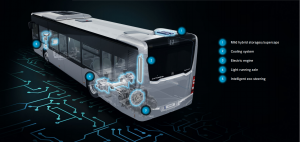
The Citaro hybrid employs a mild-hybrid system where the electric motor is mounted in between the internal combustion engine and transmission. It acts as a generator to recover energy during the braking and coasting phases.
In addition, the hybrid system assists the diesel engine during acceleration (i.e. boost phase) in two ways: by delivering traction power directly to the drivetrain via the electric motor, and by powering the bus’ 24-volt electrical auxiliaries, thus temporarily not requiring the use of the engine-driven alternator. Hence, the engine is less strained during acceleration, reducing fuel consumption by up to 8.5%.
The energy store for the hybrid system consists of roof-mounted supercapacitors, which are well-suited for quick charging and discharging. Unlike full-hybrid vehicles, mild hybrids like the Citaro hybrid are incapable of electric-only propulsion. The hybrid drive adds just 156 kg to the vehicle’s weight, which is a fraction of the weight of other electric drive systems.
Finally, the electric motor in the Citaro hybrid does not serve to increase the maximum power, but to complement the engine during its peak performance phases. The output and torque of the new Citaro hybrid remain unchanged compared to a combustion-engine Citaro of the same type and rating, and the engine speed of the combustion engine is not reduced in the boost phase.
A key benefit of the compact and technically straightforward design of the supplementary hybrid drive is that it takes up little space, so the vehicle’s outer contours remain unchanged, as does the interior – there is no loss of passenger seating. The only change is a modified maintenance hatch in the floor area.
The mild-hybrid system thus differs from the series- and parallel-hybrid diesel-electric buses that were previously trialled in Singapore. The Volvo B5LH, of which 50 units were procured by the Land Transport Authority and entered service in 2018, employs a parallel hybrid system similar in drivetrain layout to the Citaro hybrid, but paired with a much more powerful electric motor and chemical battery storage. The Volvo hybrid is also able to move under electric power independently of the diesel engine.
| Citaro hybrid | Volvo B5LH | |
| Engine Output | 220 kW @ 1800 rpm 1,200 Nm @ 1200-1600 rpm |
177 kW @ 2200 rpm 900 Nm @ 1200-1600 rpm |
| Motor Output | 14 kW / 220 Nm max | 120 kW / 800 Nm max |
Mercedes-Benz O530 Citaro C2 hybrid
One demonstrator unit of the Mercedes-Benz Citaro hybrid (Chassis Number: WEB62801923137719) was brought into Singapore for trial, on loan from Daimler South East Asia. The vehicle is not owned by the LTA, who made no further hybrid bus purchases beyond the initial batch of Volvo B5LH buses.
The bus bears the registration number SG4004B. As cited within the Road Traffic (Authorisation of Use) Notification 2020, SG4004B is permitted to operate on Bus Services 93 and 272, both of which are operated by SBS Transit. The authorization was valid from 9 March 2020 to 8 March 2021 (both dates inclusive).
The bus commenced revenue service on 13 March 2020 and was based at Ulu Pandan Bus Depot for the duration of its trial.
| Basic Technical Specifications | |
| Engine | Mercedes-Benz OM 936 h, 7700cc Power/torque rating of 220 kW (299 hp) @ 1800 rpm (80/1269/EEC) Torque rating of 1,200 Nm @ 1200–1600 rpm |
| Emissions control | Euro VI-compliant BlueEFFICIENCY Power, BlueTec® SCR diesel technology (with EGR), common-rail fuel injection system. Requires diesel exhaust fluids such as AdBlue. |
| Motor | Mercedes-Benz Integrated Starter-Alternator (ISG) Electric motor rated at 14 kW /220 Nm maximum output Acts as a generator to recharge supercapacitors during deceleration |
| Energy Store | Two modules of 16 double-layer capacitors; roof-mounted |
| Transmission | Voith DIWA 854.6, 4-speed automatic |
| Bodywork | Integral bus design. Built by EvoBus in Mannheim, Germany. |
| EDS | Luminator Ultima Electronic Display Sign (EDS) Orange LED Matrix design. Luminator Basic driver controller. |
| PIDS | LAWO INFOtainment Passenger Information Display System (PIDS) One interior-facing unit (SMART 29”), one exterior-facing unit (SMART 35.8”) |
| Driver Assistance | TNT Surveillance T-Guard – Forward collision warning system (T-FA Front Alert Camera) – Anti-Fatigue system (T-DA Driver Alert Camera) Mercedes-Benz – Side collision warning system (Sideguard Assist) – Emergency braking (Preventive Brake Assist) |
| Passenger Capacity | Seating: 28 | Standing: 65 = 93 total Not including 2 foldable seats, 2 wheelchair bays |
| Additional Specifications | Konvekta UltraLight 800 roof-mounted air-conditioning iris IRMA MATRIX Automatic Passenger Counting System (Entrance & Exit doors) City Star Eco seats Schaltbau Bode doors: Leaf doors (entrance); Sliding plug doors (exit) USB Charging Ports |
Bus Services 93 and 272 are currently served by Volvo B5LH hybrid buses, which entered service in December 2018. The allocation of SG4004B to these services reflects the possibility that SBS Transit (and/or LTA) is looking to compare the operational performance of both buses.
In compliance with LTA requirements, new public buses come fitted with a Passenger Information Display System (PIDS) comprising LED text displays, LCD display screens (interior- and exterior-facing), and interior speakers. An Advanced Driver Assistance System (ADAS), driver fatigue detection system, high-definition CCTV cameras, and passenger counters at the entrance and exit doors of the bus were just some of the additional specifications required by LTA.
The Mercedes-Benz Citaro hybrid is of the second-generation design (also known as the Citaro C2) which was launched in 2011. Older Citaro models in Singapore are of first-generation design (2005/2006-facelift).
Licensing Requirements
SG4004B was operated under a special purpose exemption, i.e. the Road Traffic (Authorisation of Use) Notification 2020, due to its non-compliance with existing Road Traffic laws. The bus, which is 12.1 metres long, exceeds the 12-metre regulation for rigid buses.
Under existing Road Traffic (Motor Vehicles, Construction and Use) Rules, section 6(1) rules:
- 6(1) – The overall length of a motor vehicle, other than an articulated vehicle, shall not exceed 12 metres.
On the roads, the bus operated under a Special Purpose License issued by the LTA.
Post Trial
Following the six-month trial in March 2021, the bus was returned to Mercedes-Benz where it was parked at the local dealer’s premises (Cycle & Carriage) for an extended period.
In late 2023, the bus was shipped to the UK. The bus was sighted at Daimler Buses UK Ltd in Coventry on 4 Jan 2023.
Exterior:
Mercedes-Benz Citaro buses are offered as integral buses, completely built up by EvoBus GmbH (a Daimler AG subsidiary) in Mannheim, Germany.
The Citaro is designed with its drivetrain components flushed to the left of the chassis, which accommodates a full-low-floor design. A third door at the rear is only possible for left-hand-drive buses—the left side is occupied by drivetrain components, and the Citaro was primarily designed for the left-hand-drive market.
The engine cooling package is mounted vertically at the rear left side of the bus, which occupies two seats at the rear of the bus. Apart from the air conditioning unit, the roof of the bus houses the supercapacitors, which are the primary energy storage medium for the hybrid drive system.
The bus is painted in LTA’s standardized Lush Green base livery, with the roof in white. Exterior decals promote the bus as an “all-new Citaro Super Cap Hybrid”.
Interior:
The bus features 28 permanent seats. Being a low-floor bus, the bus offers step-free access from entry/exit doors until the last row of seats.
Like most single-deck buses in Singapore, the Mercedes-Benz Citaro hybrid is configured with two doors: an entrance door at the front, and an exit door in the middle. The entrance doors are conventional inward-swinging leaf doors, while the exit doors are outward-swinging sliding plug doors.
Mercedes-Benz’s proprietary City Star Eco seats are paired with Yellow-Green seat covers. Unlike most buses in Singapore, both priority and non-priority seats come in the same colour tone, rather than being differentiated by colour. The front wheel arch seats are formed with fabric laid down directly onto moulded bodywork panels.
The front portion of the bus is laid out in three-abreast seating, and priority seat stickers are affixed to the side walls. Designated priority seats occupy all seats between entry and exit doors, with the exception of both forward-facing seats above the front wheel arch.
As part of new LTA requirements, the bus features two wheelchair bays; one located opposite the exit door (“right-side”), and the other just forward of the exit door (“left-side”). They each accommodate one passenger-in-wheelchair (PIW), and have foldable seats incorporated into the wheelchair backrest to offer more seating when not occupied by PIWs.
Grab poles and handgrips are located on both sides of the aisle. Nearly all seats are also fitted with hand grips to provide commuters with additional support. Metal stanchion poles and handlebars are smooth-textured and coated in bright yellow.
Bus stopping bell-pushes are located around the bus cabin, mounted to stanchion poles. Emergency hammers are located on pillars in-between windows.
The rear section of the bus sits four abreast in forward-facing and rear-facing seats. The rearmost row seats just three, as cabin space is taken up by the vertical cooling package mounted on the rear left side.
Unlike the older Production Batch Citaro buses, the rear underfloor components no longer protrude into the passenger cabin, and hence the leftmost facing seats are no longer raised with respect to other rear seats.
Driver’s Compartment
The ergonomic Citaro driver’s cab features a fully-adjustable steering wheel and dashboard, with frequently-operated controls within easy reach. A multifunction steering wheel places additional selector buttons on the steering wheel.
The turquoise display unit on the bottom left is the New Onboard Bus Equipment (NOBE) fare collection system controller. Above the NOBE is the Trapeze Common Fleet Management System (CFMS) display unit. The gear selector and door controls are on the left side of the dashboard, with the handbrake lever on the right of the driver. A CCTV monitor, located above the driver, assists with monitoring of the surroundings. The Electronic Display Sign (EDS) controllers are co-located with the CCTV monitor above the driver.
The Mercedes-Benz Citaro hybrid bus comes equipped with the Golden Eye Driver Anti-Fatigue System, supplied by TNT Surveillance. The camera unit is installed on the top of the dashboard. More driver assistance features are elaborated on later in this article.
Continued on Page 2:
- Additional Features
- USB Charging Ports
- Passenger Information Display System (PIDS)
- Wheelchair Bay
- Collision Avoidance System
- Passenger Counter
- Gallery
- Contributed Photos
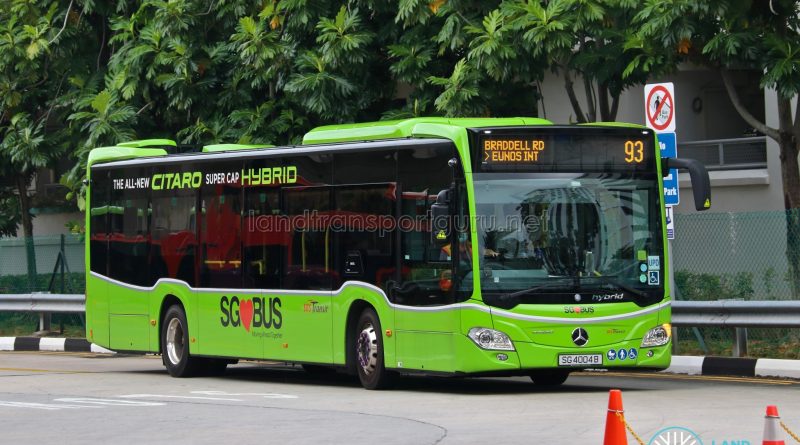
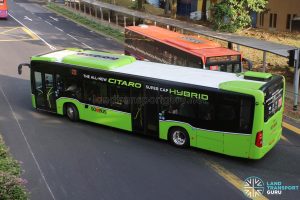
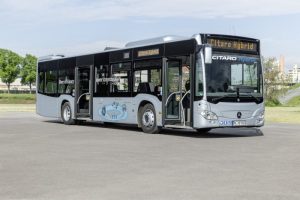
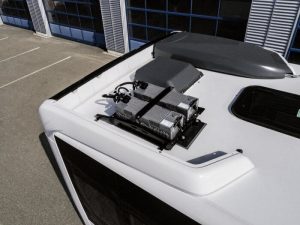
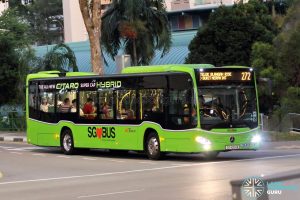
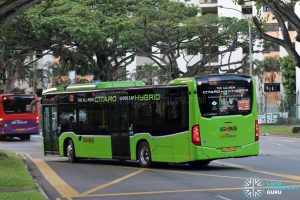
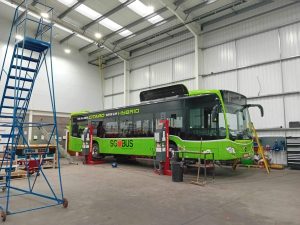
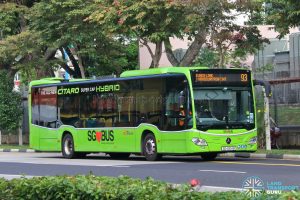

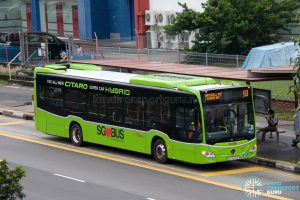

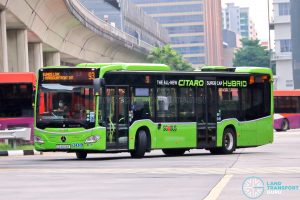
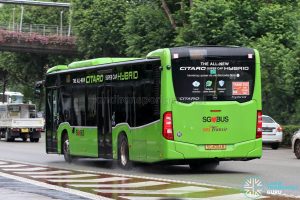
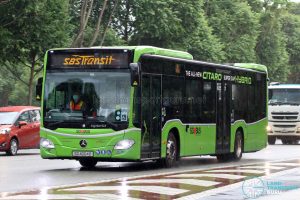
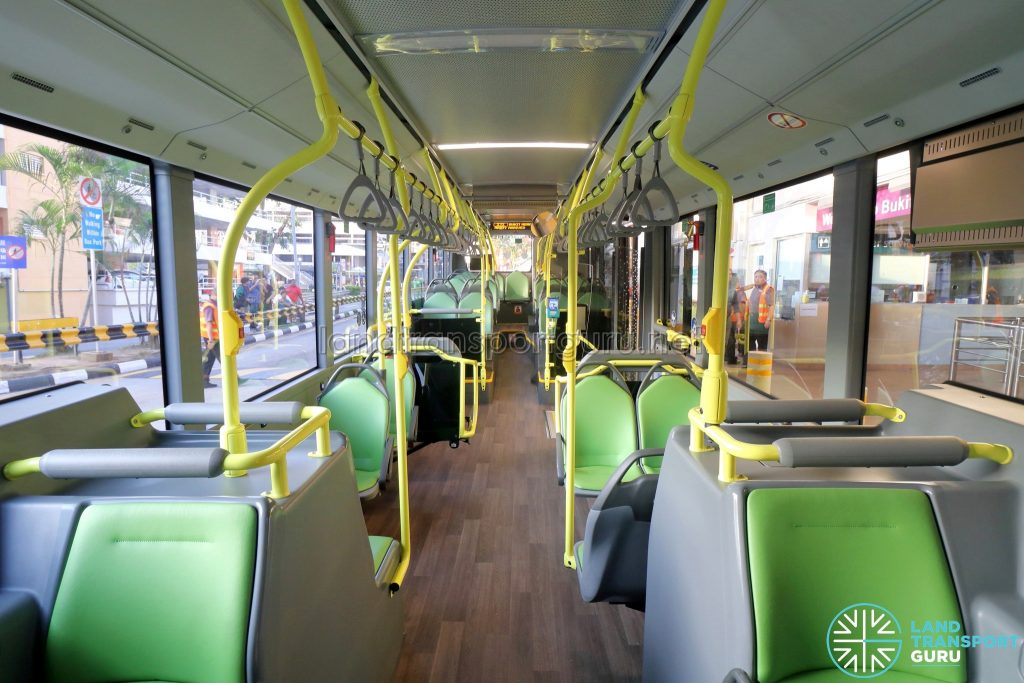
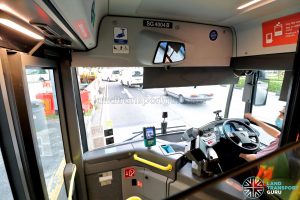
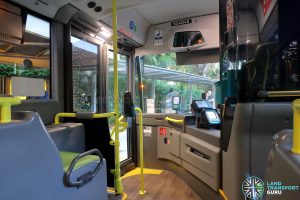
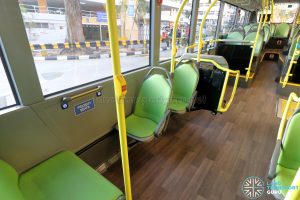
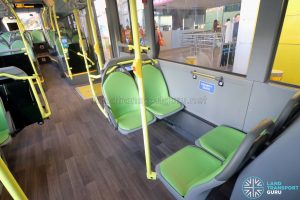
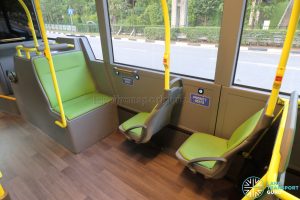
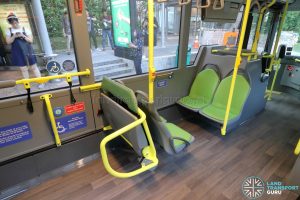
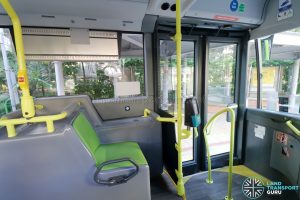
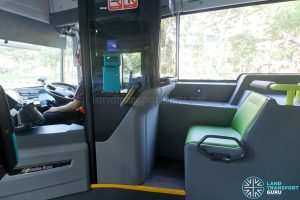
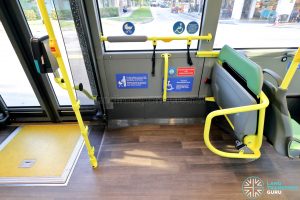
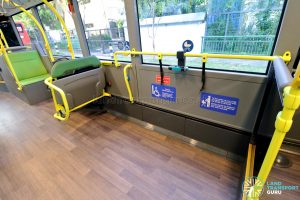
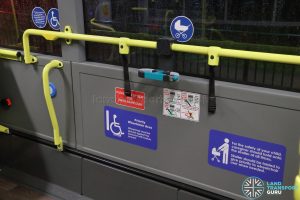
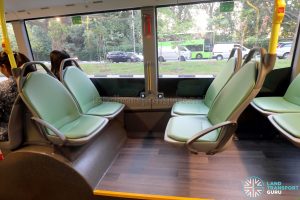
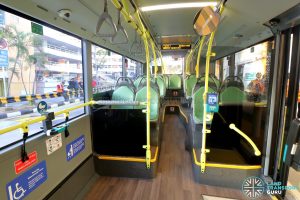
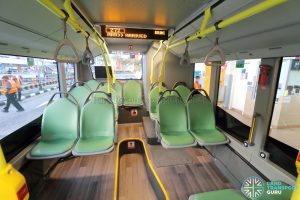
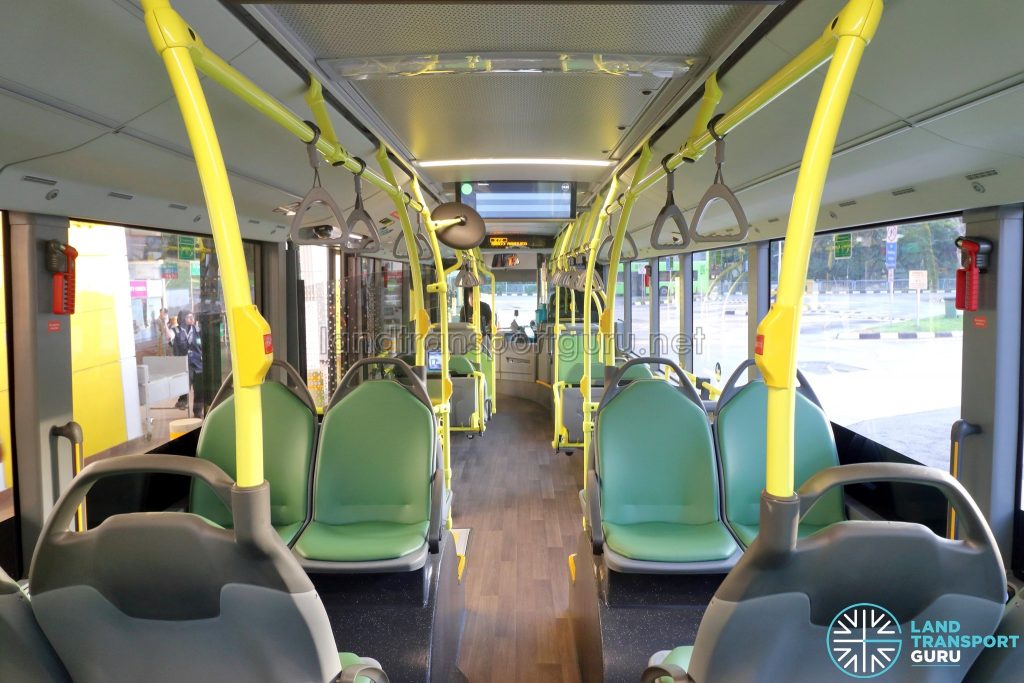
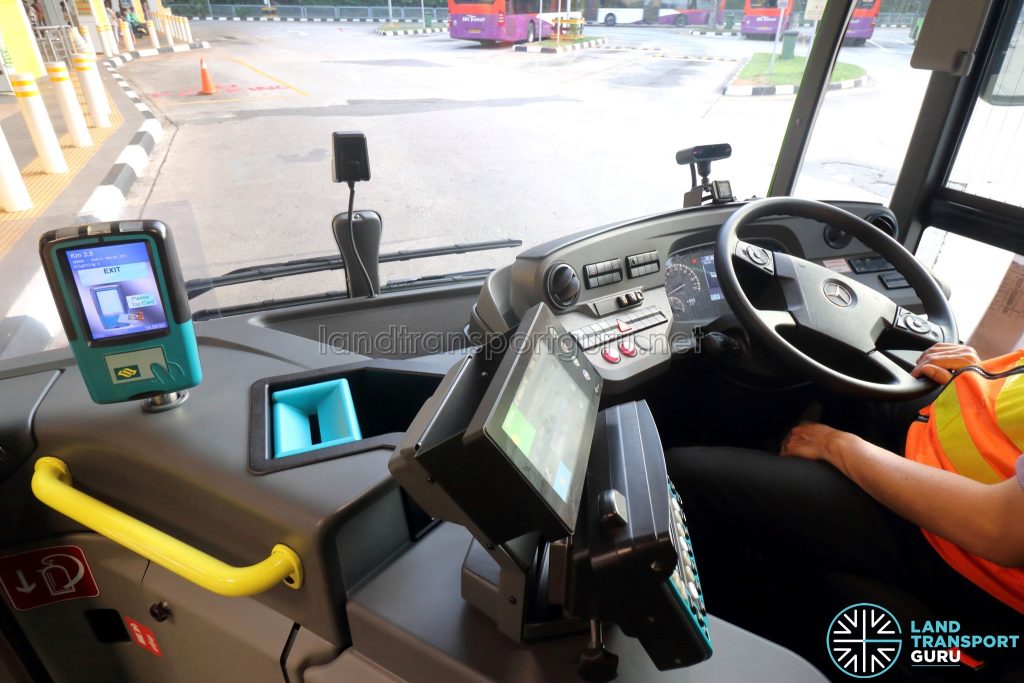
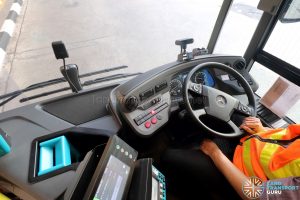
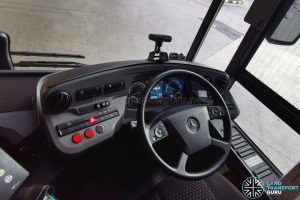
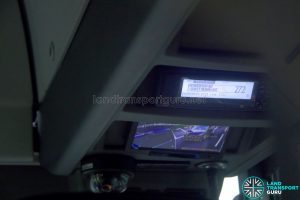
I wish that this bus will be put into OFFICIAL revenue service by next year…
Exported to UK already
This Mercedes-Benz Citaro Hybrid must be brought back to SBS Transit. Probably start launching on a few services like 5, 7, 11, 16, 16M first, then 18, 21, 22, 24, and so on…
I like MB citaro too. Is sad that LTA did not purchase after the demo. Despite LTA mentioning to either procure hybrid or electric, I think they are focusing on EV-bus